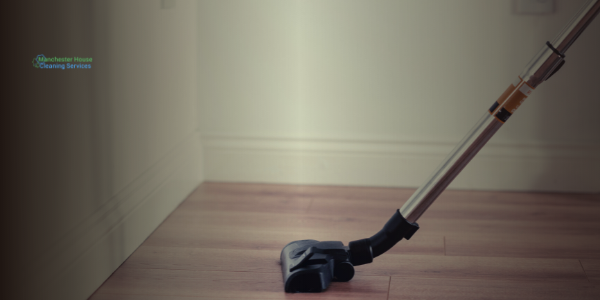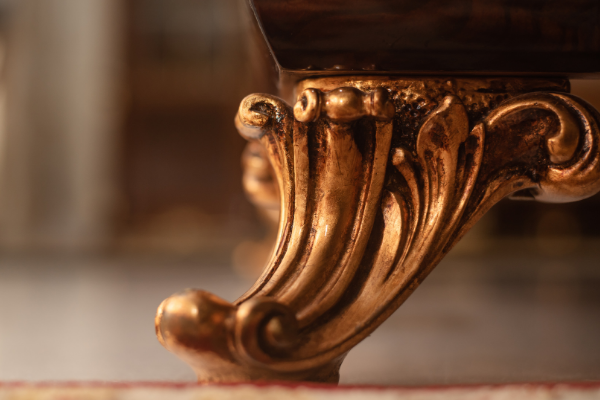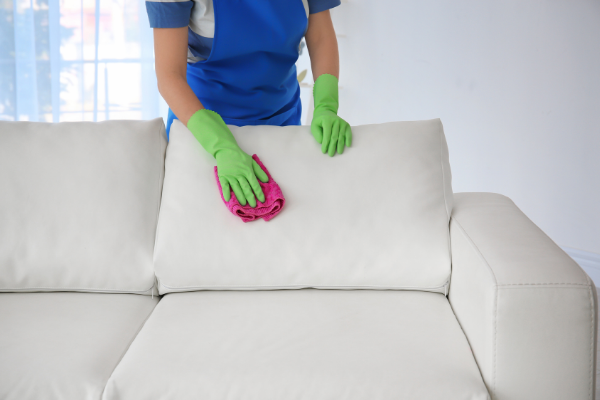
How to clean upholstery at home based on different fabrics.

Professional Upholstery Steam Cleaning is often the best and only option available for cleaning upholstered furniture. If there are particularly stubborn stains to remove it is best to reach out to a professional cleaning company.
Sofas are probably your favourite piece of furniture. And why not you can relax after a hard day's work, spend a lazy weekend watching tv or reading a book. However, through constant use by the entire family and (and pets) you will inevitably be faced with a challenge. How to clean your upholstered furniture? Realistically, there are two options you have you can reach out to a professional cleaning company and inquire about upholstery cleaning or go the DIY route. Provided you do not have massive, stubborn stains on your sofa or armchair and the soiling is relatively light you could adequately clean your sofa on your own, of course, if you are armed with the right knowledge on how to do so. For stubborn stains and a lot of soiling steam cleaning is your best option. In any other instances, you could quickly and easily clean your favourite couch and have it sparkling clean by just using handy supplies you already have at home. If you follow these easy steps you will be amazed at the results you can achieve.
1 - Clean with a vacuum cleaner.

The first cleaning tool you should reach for when you are cleaning upholstery is the vacuum cleaner. It does not necessarily need to have a steam cleaning function. You will use the vacuum cleaner to suck out any dust that is stuck on the upholstery of your furniture. You should thoroughly hoover your couch or armchair to remove not only dust but also any pet hairs.
Use the strongest function you have and do not forget to clean under the cushions back and armrests, dirt, crumbs and other soiling will easily be trapped there.
2 - Removable Covers? You are in luck.
Removable covers on your sofa are a true gift, you can easily clean them in the washing machine. If that is the case with your sofa all you will have to do is clean any fixed parts of your sofa - backrest, armrest and the upholstery at the front.
You do have to be careful when you are placing the covers in the washing machine and pay attention to the type of material the upholstery is made of. Routine cleaning of your sofa should not lead to you having to reupholster your furniture because you destroyed the covers in the washing machine. So be careful. Use the amount of dirt you have on your sofa as a gauge to determine which setting you should use to wash your upholstery covers. If you are still uncertain a useful tip is that the temperature of the water should not exceed 40-50 degrees C.
3 - Cleaning wooden and metal components.

This is quite possibly the easiest part of your DIY upholstery cleaning journey as the likelihood of making a mistake is pretty much non-existent. Wooden and metal components of the sofa can be cleaned by simply using cooler water and dishwashing liquid. If there are any stubborn fatty stains on the legs of your sofa or armchair add a little bit of lemon juice to this cleaning solution. The acid will help dissolve the stain and make cleaning easier. It is also a good idea to clean any wooden parts using a soft textile cloth and appropriate detergent meant for furniture. You will be able to simultaneously remove any dust and polish the wood. You can use a special polishing paste to polish any metal ornaments, they should be available in most larger stores.
4- Removing stains.

For most of us cleaning your upholstered furniture will mean removing stains from the upholstery. There are specially made cleaning solutions that supposedly help you eliminate stains from your upholstery on your own. The problem with most of those cleaning detergents is that they tend not to work. Most commercially available cleaning solutions for stain removal set stains in they do not eliminate them. Your best bet for getting rid of a stain from your sofa is steam cleaning. Professional upholstery cleaning is the most certain way to completely remove stains from your upholstery. If you are going to stick with the DIY approach and are not a fan of using chemicals there are a few home cleaning tips and tricks you can try. In both instances, you should approach stain removal as professional cleaning companies do and base the detergent you are going to use on the nature of the stain and the material of your upholstery. If you do not you are risking damage to the fabric and bleeding the colour.
If you are going to go with the eco-friendly approach to stain removal from your upholstery, here are a few home-made all-natural detergents you can use to treat different types of upholstery materials.
For textile fibres: Mix 1/4 cup of vinegar with 3/4 of a cup of warm water and a tablespoon of dishwashing liquid. Pour this mixture into a spray bottle and spray the stain from a distance. Use a soft cloth to srub the stain until the stain disappears. Remove the soap with a wet towel and dry it using a dry clot.
For leather upholstery: Mix 50 ml of olive oil with 1/4 cup of vinegar. Pour this mixture into a spray bottle and spray the entire surface. Treat with a soft and dry cloth. If you clean your leather upholstery in this way you will at the same time clean and polish the leather finish.
For synthetic materials: Mix 1/2 cup of vinegar with 1 Cup of warm water and half a tablespoon of dishwashing detergent, pour into a spray bottle and spray the stains directly. Rub with a soft cloth until the stains dissolve and disappear.
5 - Drying.
Drying is a mandatory step anytime you have cleaned your upholstery on your own. Naturally, you would like to use your upholstered furniture as soon as possible. You have to remove any excess moisture, you can do so using a soft dry towel or other absorbing means.
If your upholstery is still slightly damp you can use a fan or an electric heater to speed up the drying time. Keep in mind that excess moisture that has been left unattended on your upholstery can cause mould to start growing on the inside of your sofa.
7 - Taking care of natural upholstery materials.

Natural leather sofas are highly valuable and specific. Any fans of that type of upholstered furniture should know and appreciate the characteristics of this material and store and maintain it correctly. Natural leather sofas are incredibly delicate and are easily prone to damage. To maintain the appearance of your sofa longer you have to correctly clean it. Natural leather can absorb a fair bit of moisture so keeping it overly dry can destroy the upholstery. On the other hand, keeping natural leather too wet can have a different adverse effect, mould and mildew can develop. The key to successfully maintaining natural leather upholstery lies, as most things in life often do, in balance. Air humidity cannot exceed 30-70 % and temperatures cannot go past 25 degrees C. You shouldn't place leather furniture next to heating elements or have sunlight directly glowing over it. If your leather upholstery is exposed to too much sunlight or direct heat it can become brittle and crack. The colour of your leather sofa can also change due to the heat, if it is a lighter colour yellowing can appear and darker shades can become pale in places.
Natural leather has a larger grain and is porous, therefore, it can be damaged easier than glossier finishes because it absorbs substances easier, leather can absorb both liquids and dust with ease. A crucial step you have to take in everyday care for your leather furniture is removing dust. Dust that has collected in the pores of the leather fabric will form a hard layer that damages the fabric. You have to remove dust by hand from your upholstery, clean it with a soft, microfiber towel. You can remove spills from your leather sofa you can use a delicate textile towel to collect any liquid. You can remove any visible stains or colour marks from your sofa with a homemade cleaning solution comprised of vinegar or lemon juice. You can also use alcohol that has been diluted down to a lower abv mixed with salt or baking soda. Avoid using detergents that are sold in stores or at least approach them with extreme caution. If you are going to use commercial products you have to make sure that they will not negatively impact your sofa and that they are not too aggressive.
Now that you have taken care of drying and cleaning your sofa it is time to move to moisture. This process you should do several times a year. Any product that contains wax, vegetable oil or glycerin will be beneficial to your leather upholstery. Apply a very thin layer of product on top of your leather upholstery and gently and carefully soak it up a few hours later.
8 - Steam Cleaning.
When cleaning upholstery one of the best advantages professional cleaning companies have is steam cleaning. Given that you have the appropriate equipment you can also steam clean upholstery at home on your own. Hot steam dispersed under pressure can thoroughly eliminate not only dust and stains but also different microorganisms. The main advantages of steam cleaning over the other methods are that through this method you remove dust, wash and disinfect your upholstered furniture. The result is an impeccably clean fabric that has a pleasant aroma. Moreover, using highly concentrated alkaline cleaning materials is avoided, such cleaning solutions can produce toxic residues.
Steam cleaning is eco-friendly and professional steam cleaning eliminates the problem of residual moisture on your fabric. If your sofa is not properly dried the risk of mould and mildew developing is always present. Dust, fatty stains and colour marks are dissolved in minutes and the upholstery fibres are not under any threat of being damaged.
Through steam cleaning, you also disinfect the air in the room. Upholstery tends to collect a lot of dust that sticks to it and saturates the air in the room with dust particles. These dust particles create an environment for microorganism to develop.
It is helpful to have a steam cleaner handy, it has many uses throughout your home, not limited to cleaning upholstery. If you are short on storage space or do not have the time or energy to become familiar with this piece of cleaning equipment be sure that a professional cleaning company will easily steam clean any upholstered item you have in your home.
Manchester House Cleaning Services.


















